Gregory A. Fournier's Blog, page 34
January 1, 2015
The Rainy Day Murders--2015 New Year's Progress Report

For the last six months, people have been asking me when The Rainy Day Murders--my true crime account of the Washtenaw County Michigan murders--will be available. My short answer is when it is ready. Last month, my editor returned my manuscript and recommended that I read her remarks and comments, then step away from it for awhile and let my subconscious go to work.
What great timing! The 2014 holiday season gave me the time and space to think about the project without working on the day-to-day subject matter. As I begin 2015, my first priority is to revise my manuscript and seek publication. I am confident that the final product will be all the better for it. Everyone personally involved with or affected by these senseless murders of seven young women--in the late 1960s--deserves nothing less.
The grim details of these tragedies speak for themselves. Now, I need to tighten-up my narrative and increase the manuscript's sense of time and place--both suggestions from my San Diego editor, Jean Jenkins. Any author has only two eyes, and seeing things from the informed perspective of a skilled editor helps bring out areas of weakness that might otherwise be overlooked. As the High Lama in the novel Lost Horizon notes, "The eye sees but doesn't see itself."
Published on January 01, 2015 07:39
December 27, 2014
Antoine Cadillac--Detroit's First Godfather
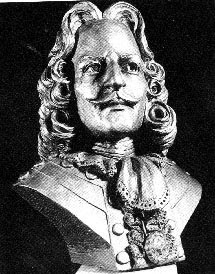 Bust of Antoine de la Mothe CadillacAn expedition financed by the French monarch--King Louis XIV--and promoted by his Minister of Marine--Comte de Pontchartrain--appointed Antoine de la Mothe Cadillac as their agent to establish a fur trading post and fort in New France. In return, Cadillac was granted generous riverfront real estate. He envisioned a permanent French colony controlling the fur trade routes through the upper Great Lakes, with him at the helm.
Bust of Antoine de la Mothe CadillacAn expedition financed by the French monarch--King Louis XIV--and promoted by his Minister of Marine--Comte de Pontchartrain--appointed Antoine de la Mothe Cadillac as their agent to establish a fur trading post and fort in New France. In return, Cadillac was granted generous riverfront real estate. He envisioned a permanent French colony controlling the fur trade routes through the upper Great Lakes, with him at the helm.Commander Antoine Cadillac led a fleet of 25 large canoes--with 50 soldiers, 50 empire builders, 2 Roman Catholic priests, and his 11-year-old son--on a 52 day trip westward from French-controlled Montreal to the western bank of a swift running river that connected Lac Erie with Lac St. Clair.

This site was chosen because it was the narrowest point of the strait--de troit--which is how Detroit earned its name. There was an eroded 40' clay bluff leading up from the river bank to a flat clearing. Once a fort was built on the plain--anything moving up or down the river could be seen and was in easy range of their cannons. This was a defensible position to discourage the British and control the fur trade.
The empire builders arrived on July 23, 1701 and began work on a log fort Cadillac named after his benefactor--French Minister of Marine--Comte de Pontchartrain. Two days later, a mass was said in honor of Ste. Anne--the patron saint of France and mother of the Virgin Mary. After the service, the foundations for the church were laid. Catholicism had come to the wilderness.
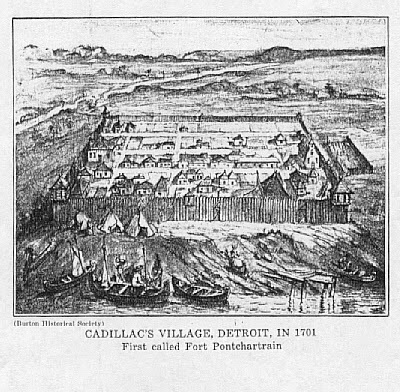
Fort Pontchartrain contained a warehouse which also doubled as a store. There were also two guard houses, Ste. Anne's Church, and about 15 houses within the fort. Lots could be no larger than 25 square feet and some were smaller.
In a report about Detroit to his superior officers, Cadillac noted, "Especially attractive was the region that lies south of the pear-like lake to which they gave the name of St. Clair, and the country bordering upon that deep, clear river, a quarter of a league broad, known as Le Detroit.
"On both sides of this strait lie fine, open plains where the deer roam in graceful herds, where bear, by no means fierce and exceedingly good to eat, are to be found, as are also the savory poules d'Indies (wild duck) and other varieties of game. The islands are covered with trees; chestnuts, walnuts, apples, and plums abound; and in season, the wild vines are heavy with grapes.
"Le Detroit is the real center of the lake country--the gateway to the West. It is from there that we can best hold the English in check."
French trade with the local Native American tribes went well for the most part. Cadillac encouraged the Ottawa, Huron, Pottawatomie, Miami, and Wyandotte tribes to cluster together in villages near the fort for protection from their mutual enemies--the Iroquois and the British. In total, Cadillac estimated that there were about 2,000 Indians in and around Fort Pontchartrain allied with the French.
In 1702, the first European baby born in Detroit was the daughter of Alphonse de Tonty--Cadillac's second-in-command--and his wife. Not to be outdone--in 1704--the Cadillac's gave birth to Marie Therese, who became the first recorded baptism christened in Ste. Anne's Church registry.
Cadillac wanted the settlement to grow rapidly, but few if any unattached women were available to single men, so he proposed that christened Indian women be allowed to marry French settlers. The Jesuit priest strongly objected on moral and religious grounds, and the plan was soon rejected. This is likely the first official instance of discrimination in Detroit's long history.
 In 1707, Cadillac began issuing farm grants--known as ribbon farms--to attract new settlers. These farms ranged from 200' to 1,000' wide and extended from the shoreline for 2 or 3 miles. Each farm had waterfront access. Many of Detroit's current street names derive from the original ribbon farm grant holders--for instance--Beaubien, Campau, Livernois, Riopell, Dequindre, and others. Cadillac plotted out 68 parcels.
In 1707, Cadillac began issuing farm grants--known as ribbon farms--to attract new settlers. These farms ranged from 200' to 1,000' wide and extended from the shoreline for 2 or 3 miles. Each farm had waterfront access. Many of Detroit's current street names derive from the original ribbon farm grant holders--for instance--Beaubien, Campau, Livernois, Riopell, Dequindre, and others. Cadillac plotted out 68 parcels. Cadillac acted like a feudal landlord requiring farmers to pay him an annual rent and a percentage of their grain to use the mill he had built on the waterfront north of the fort. He was the mill's sole proprietor and could charge whatever he wanted. Renters were also required to work on Cadillac's farm for a specified number of days each year.
To engage in any kind of trade, settlers had to pay a licensing fee and annual taxes. Cadillac grew rich by padding the fees and taxes and skimming off the top. When he withheld the allotment of imported brandy behind padlocked warehouse doors, it was discovered--and reported--that he was trading it to the Indians for beaver pelts. He had defied a Royal decree not to provide liquor to the native population.
When complaints about Cadillac reached Montreal and Paris, King's Deputy Francois Clarembault went to survey Detroit area holdings in 1708 and found they did not match Cadillac's reports. After nineteen days in Detroit, Clarembault returned to Canada and sent his findings off to France. In 1709, Count Pontchartrain wrote to Cadillac complaining that he showed "too much greed and little moderation in his dealings with the settlers."
In 1710, Cadillac was called to Quebec to answer charges against him brought by his detractors. He was acquitted of extortion and abuse of power charges but was removed from his post--never to return to Detroit. The following year, Cadillac was promoted to the governorship of the Louisiana Territory.
Published on December 27, 2014 06:47
December 20, 2014
Detroit's Saint Anne Roman Catholic Church--the Second Oldest Continuous Operating Parish in America
 Stained-glass Windows in Saint Anne's Catholic Church in DetroitAs history records--on July 24, 1701--Antoine de la Mothe Cadillac and his troop of 105 soldiers and settlers arrived in what became known as Detroit. It took the expedition's 25 canoes 55 days to paddle upstream from Montreal to a clearing on the western bank of the strait that gives Detroit its name. This site was chosen because Cadillac felt it was defensible with plenty of game to help sustain them.
Stained-glass Windows in Saint Anne's Catholic Church in DetroitAs history records--on July 24, 1701--Antoine de la Mothe Cadillac and his troop of 105 soldiers and settlers arrived in what became known as Detroit. It took the expedition's 25 canoes 55 days to paddle upstream from Montreal to a clearing on the western bank of the strait that gives Detroit its name. This site was chosen because Cadillac felt it was defensible with plenty of game to help sustain them.Two days later, the first mass was said in Detroit--on the feast day of Saint Anne's--and the foundations for a small chapel were laid. Catholicism had come to the wilderness. It was the first building constructed in Fort Pontchartrain du Detroit and named after the patron saint of France.
Saint Anne was the grandmother of Jesus Christ and the mother of the Virgin Mary in biblical heredity. Though long considered the patron saint of Detroit, Ste. Anne was installed officially as the patron saint of the Archdiocese of Detroit in a September 2009 decree issued by Pope Benedict XVI.
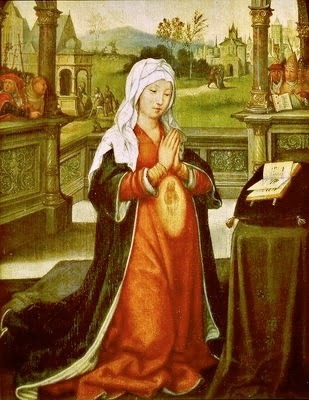 Saint Anne Conceiving the Virgin Mary by Flemish Painter Jean BellegambeOver the years, there have been as many as eight different church buildings--though archaeologists and historians can't agree on an exact number. The original Ste. Anne's was made of logs and planks and was burned down by Native Americans in 1703--including the chapel, the rectory, part of the fort, and the parish's baptismal records. The church was rebuilt in 1704.
Saint Anne Conceiving the Virgin Mary by Flemish Painter Jean BellegambeOver the years, there have been as many as eight different church buildings--though archaeologists and historians can't agree on an exact number. The original Ste. Anne's was made of logs and planks and was burned down by Native Americans in 1703--including the chapel, the rectory, part of the fort, and the parish's baptismal records. The church was rebuilt in 1704.Ste. Anne's has succumbed to flames on two other occasions during its 314 years of existence. A larger church was built in 1708 outside the palisade of Fort Pontchartrain. The settlers burned it down themselves in 1714 during a Native American uprising. They feared that it would offer cover to the Indians, so they sacrificed it.
And in 1805, most of Detroit was destroyed by an accidental fire--all but one of 300 buildings were burned to the ground--including Ste. Anne's. A new church building was begun in 1818 and completed in 1828.
Locally revered, Father Gabriel Richard arrived at Ste. Anne's in 1796. He was not only a theologian but also a politician. He was a co-founder of Catholepistemaid du Michigania--which evolved into the University of Michigan--and as territorial representative to the United States Congress from the Michigan Territory, he helped establish a road-building project that connected Detroit with Chicago--now known as Michigan Avenue.
In 1832, after caring tirelessly for Detroit's cholera victims, Father Richard succumbed to the disease on September 13th. Legend notes that he was the last person to die from the outbreak. His body is interred under the altar of Ste. Anne's side chapel

The current Gothic Revival Cathedral--designed by architects Leon Conquard and Alert E. French in 1886--has flying buttresses, four gargoyles, and the oldest stained glass in the city of Detroit. They all reflect European French influence. Ste. Anne's Cathedral was listed on the National Register of Historic Places in 1976.
More interesting background information on Saint Anne:
http://www.saintanne.webhero.com/st-anne-patron-saint-of-housewives.htm
Published on December 20, 2014 05:18
December 13, 2014
Dead Reckoning by Caitlin Rother
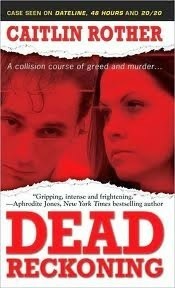 Caitlin Rother's 2011 true crime book--Dead Reckoning--tells the twisted murder-for-profit tale of diabolical killers Skylar and Jennifer Deleon. This young married couple schemed to defraud a retired couple--Tom and Jackie Hawks--of their financial assets and their 55' yacht before tying them to an anchor and shoving them into the Pacific Ocean. The use of a nautical term for the title of this book is most appropriate.
Caitlin Rother's 2011 true crime book--Dead Reckoning--tells the twisted murder-for-profit tale of diabolical killers Skylar and Jennifer Deleon. This young married couple schemed to defraud a retired couple--Tom and Jackie Hawks--of their financial assets and their 55' yacht before tying them to an anchor and shoving them into the Pacific Ocean. The use of a nautical term for the title of this book is most appropriate.Caitlin Rother brings her considerable talent--as a Pulitzer Prize nominated journalist--to guide her readers through the complexity of this multi layered case with clarity and precision reflecting her nineteen years as an investigative reporter. Rother's skillful narrative carries the reader along to help contextualize what would otherwise be an overly complicated story.
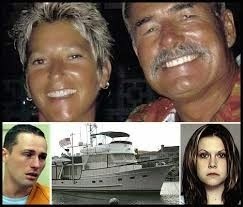 Skylar Deleon's personal revelation--behind bars--of his motivation for killing the Hawkses is an unexpected jaw dropper. This is a story of sociopathic greed and ruthless people who were blinded by the same thing--the color of money.
Skylar Deleon's personal revelation--behind bars--of his motivation for killing the Hawkses is an unexpected jaw dropper. This is a story of sociopathic greed and ruthless people who were blinded by the same thing--the color of money.For two days, I did little else but turn pages of this satisfying true crime read.
Aphrodite Jones interviews Skylar Deleon in prison: https://www.youtube.com/watch?v=qSvmpfCVrD0
Published on December 13, 2014 11:49
December 9, 2014
Serial Killer Groupie Sondra London Interview--Parts Two and Three
 Sondra LondonWhile researching serial killers and why they do what they do, I am amazed at how easily they can rationalize their actions and take pride in them. This perverse narcissism is disturbing and repulsive to most people.
Sondra LondonWhile researching serial killers and why they do what they do, I am amazed at how easily they can rationalize their actions and take pride in them. This perverse narcissism is disturbing and repulsive to most people. But there are those people who are in love with lunacy and attracted to these psychopaths. Serial killer groupie Sondra London is a case in point. After establishing a relationship with serial killer Gerald Schaefer, London dropped him for another serial killer Danny Rolling and played one man against the other. Trying to figure out human nature is complicated and often heart-breaking.
If part one of Sondra London's interview--in my last post--wasn't enough to make you lose sleep--parts two and three will send you ranting into the darkness.
Part two: https://www.youtube.com/watch?v=g27LWxWtwzA
Part three: https://www.youtube.com/watch?v=EAc8BnmSNmY
Published on December 09, 2014 06:59
November 26, 2014
Detroit's Griot of Griswold Street--Larry Mongo--on The Blue Vein Society
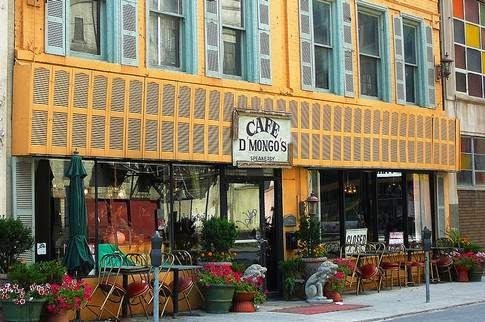
In a hidden pocket--a couple of blocks up and over from Grand Circus Park in downtown Detroit--Cafe D'Mongo's Speakeasy is tucked within a very short block. Owner Larry Mongo bought the business in 1985 from the Greek Seros family. At one time, the building contained an old-fashioned soda shop.
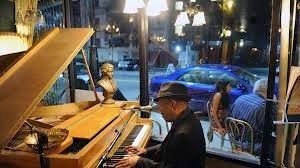 There is a low counter top and stationary stools bolted to the floor, there are also four booths. Behind the booths is a wall separating an area with upholstered chairs and a few small tables facing a grand piano where the Speakeasy's house band Carl and Company--led by Carl, the Human Jukebox--performs after 8:00 PM on Friday and Saturday nights. The bar is open from 5:00 PM until closing.
There is a low counter top and stationary stools bolted to the floor, there are also four booths. Behind the booths is a wall separating an area with upholstered chairs and a few small tables facing a grand piano where the Speakeasy's house band Carl and Company--led by Carl, the Human Jukebox--performs after 8:00 PM on Friday and Saturday nights. The bar is open from 5:00 PM until closing.There is no better way to describe D'Mongo's Speakeasy than an authentic Detroit dive. The interior decoration looks like a museum of Detroit memorabilia. Its walls are loaded with photos that harken to Detroit's underworld past, mixed with vintage photos of the Mongo family from the 1920's onward. Many celebrities have made the pilgrimage to D'Mongo's--Quentin Tarantino for one and Ryan Gosling for another.
 Larry Mongo and Quentin Tarantino
Larry Mongo and Quentin TarantinoIn early October, Larry invited my researcher Ryan M. Place and I to attend a taping at Cafe D'Mongo's Speakeasy for a program called Ten Best Bars In America for Esquire magazine. The joint was packed with the new face of Detroit--a mixture of young, upwardly mobile Detroiters.
***
The Mongo family has had a long and fabled history in Detroit since the first four Mongo men left South Carolina in 1906 to avoid the long arm of the law. During prohibition, the Mongo family had to pay off the Purple Gang, so they could safely operate a chain of fish stores in the Detroit area--which the gang used to launder their bootlegging and brothel profits. This relationship gave that generation of Mongo's a certain level of protection, power, and respect on the street.
In more recent Detroit history, Larry and his younger brother Adolph have been political advisers to black mayors from Coleman Young--Detroit's first black mayor--to Kwame Kilpatrick. When things went terribly wrong in the Kilpatrick administration, the Mongo's wisely stepped aside.
One afternoon, I was able to meet and talk with Larry Mongo about the issue of race which has dominated Detroit politics for the last fifty years. Being an Ofay--derisive black term for a white person--I wasn't aware of something which social scientists have labeled pigmentocracy. Within the American black population at the turn of the twentieth-century up until the 1960s, wealth and status were regulated by shade of skin color.
"There was an interracial caste system in the black community where dark skinned blacks were looked down upon by lighter skinned blacks as being genetically inferior," Larry Mongo explained. "There was something called The Blue Vein Society where a person had to show his or her forearm to look for a dark blue vein to determine if the person was mixed race or not.
"Inner racism was worse at times than outer racism. We classified ourselves by shade of color or how much African blood you had. You might be described as an octoroon--a person of one-eighth African blood--or a mulatto--bi-racial or somewhere in between."
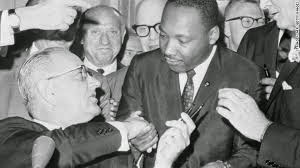 President Johnson and Martin Luther King at signing of the 1964 Civil Rights bill.
President Johnson and Martin Luther King at signing of the 1964 Civil Rights bill.I asked Larry Mongo about the impact of the 1964 Civil Rights Act on Detroit's black community. "After the Civil Rights Act--passed by Lyndon Johnson's administration--everything changed in the black community and neighborhoods," Larry explained.
"Don't get me wrong, things weren't perfect back then, but everyone knew their place and the color lines were clearly drawn. Cross them and you did so at your own risk. That was in the heyday of the Jim Crow--separate but equal--laws.
"All manner of black businesses catered to black neighborhoods and things usually went okay. Everyone was getting by. When the Jim Crow laws were repealed and the Civil Rights Act was passed into law, more affluent blacks could spent their money in white establishments like hotels and restaurants which had been off limits before.
Patterns of segregation--previously enforced by red-lining and real estate covenants--became illegal and drew middle-class blacks out of the ghettos into outlying areas. This migration drew valuable resources out of the black neighborhoods.
"Many black businesses were mom-and-pop operations in neighborhoods that could no longer support them. These
neighborhoods went into further decline struggling to survive. Then in the sweltering heat of July 23rd, 1967--all hell broke loose on 12th Street--Detroit started to burn.
"When (Antoine) Cadillac came here in 1701, it took 250 years to build up Detroit. This city has rotted from the inside out. Detroit needs a new economy--then business growth will begin to feed everything else. The city will survive only by creating wealth and decent jobs to help our residents pull themselves out of poverty and despair. More of our young people need to go to school rather than jail. They need to go to the library instead of the street corner. Now that will be a real revolution."
***
After my afternoon visit with Larry Mongo, I decided to Google the Blue Vein Society to learn more about it. From there, my research led me to several other culturally historic facts about the black community in the first half of the twentieth-century.
 The phrase Blue Vein Society originated at the end of the nineteenth-century, according to American author Charles W. Chesnutt in 1898. "This is a group which limited its membership to blue veins--light-skinned black people white enough to show blue veins on their forearms.
The phrase Blue Vein Society originated at the end of the nineteenth-century, according to American author Charles W. Chesnutt in 1898. "This is a group which limited its membership to blue veins--light-skinned black people white enough to show blue veins on their forearms."At the turn of the century, there were many American cities with Blue Vein Societies representing the miniscule black upper and upper-middle classes. The negro Blue Vein Society mimicked the white patrician Blue Blood Societies. Their primary purpose was to sponsor balls and galas as meeting places for eligible blue veined youth."
The Creoles in Louisiana formed almost a separate class of black American because they tended to be better educated with lighter skin--the children of more generations of co-mingling with European whites--especially the French and Spanish.
Another phenomenon of black cultural pigmentocracy--a carry over from the nineteenth century--was the paper bag test which originated in New Orleans. A brown paper bag would be attached to the entrance of a party or event--for instance--and anyone darker than the paper bag was denied admittance. This test was said to have been used in many churches, fraternities, and nightclubs.
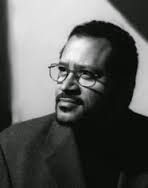 Michael Eric DysonAmerican author Michael Eric Dyson wrote, "The brown paper bag test is a metaphor for how the black cultural elite literally established a caste (system) along color lines within the black community. This is one of the ways blacks with European ancestry attempted to isolate and distinguish themselves from those who are mostly African."
Michael Eric DysonAmerican author Michael Eric Dyson wrote, "The brown paper bag test is a metaphor for how the black cultural elite literally established a caste (system) along color lines within the black community. This is one of the ways blacks with European ancestry attempted to isolate and distinguish themselves from those who are mostly African."My research also revealed some other labels still used within the black community. A redbone describes light coppery or caramel colored skin with red overtones in the hair, sometimes with freckles and sometimes not. A yellowbone--also called high yellow--is slang for light-skinned black females who could often pass as a white person. This was the world before the 1964 Civil Rights Act. In an attempt to secure a better life in segregated American, many light-skinned, mixed-race blacks crossed the color line as reborn descendants of European ancestry and never looked back.
The history of mankind is rife with examples of one group--who perceives itself as superior--foisting itself upon another group--who is perceived as inferior. This oppression takes many forms but always ends up the same way--with someone being discriminated against.
Published on November 26, 2014 17:02
November 19, 2014
Murderabilia - Market for the Macabre
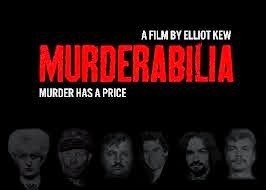 Since the 1970s, there has been a growing consumer market in serial killer themed merchandise and artifacts. Murderabilia refers to the collection, sale, and marketing of original artwork, articles of clothing, and personal possessions of notorious killers in general and serial killers in particular. Stories and books about serial killers have great appeal with the public and attest to the popular interest in this type of murder.
Since the 1970s, there has been a growing consumer market in serial killer themed merchandise and artifacts. Murderabilia refers to the collection, sale, and marketing of original artwork, articles of clothing, and personal possessions of notorious killers in general and serial killers in particular. Stories and books about serial killers have great appeal with the public and attest to the popular interest in this type of murder.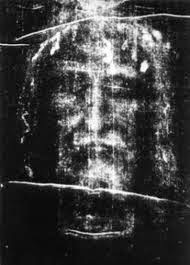 Image from the Shroud of TurinSince biblical times, religious relics and artifacts were believed to have sacred qualities, a belief which carries down to our present day. The sale of splinters and nails from the crucifixion of Christ were sold throughout Europe during the Middle Ages, and the Shroud of Turin still has the ability to inspire the faithful, even after the discovery that it was made of Medieval period linen. The Catholic faithful still have their rosaries and scapulars blessed by the parish priest.
Image from the Shroud of TurinSince biblical times, religious relics and artifacts were believed to have sacred qualities, a belief which carries down to our present day. The sale of splinters and nails from the crucifixion of Christ were sold throughout Europe during the Middle Ages, and the Shroud of Turin still has the ability to inspire the faithful, even after the discovery that it was made of Medieval period linen. The Catholic faithful still have their rosaries and scapulars blessed by the parish priest.The trade in items belonging to serial killers or objects having been touched by them is the antithesis of religious relics or items like mass cards and rosary beads that have been blessed. It is believed that these items have an atavistic quality to them, but rather than being imbued with the sacred, serial killer artifacts are tainted with the profane.
The fascination with death and the dark side of humanity has a long history. The display of the bodies of the infamous have always drawn large crowds of gawking, respectable people. The public viewing of the Dalton Brothers and the James Gang comes to mind. In more recent times, John Dillinger and Bonnie and Clyde's bodies were photographed and given wide circulation in newspapers across American. In many places in America, hangings were public events, especially of ruthless killers.
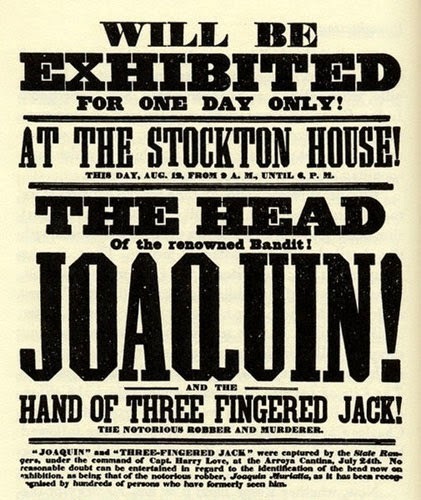 The severed head of Joaquin Murrietta, legendary Mexican outlaw, was popular on the medicine show circuit in the Southwest and drew huge crowds. So many people were willing to pay to see the notorious bandit that several severed heads were known to be touring at the same time. For many people, the sight of a severed head pickled in a jar of alcohol was enough of an attraction regardless of the true identity of the victim. Touring attractions such as Al Capone's bulletproof car and the bullet-riddled car of Bonnie and Clyde still have the power to attract crowds at county fairs and other venues.
The severed head of Joaquin Murrietta, legendary Mexican outlaw, was popular on the medicine show circuit in the Southwest and drew huge crowds. So many people were willing to pay to see the notorious bandit that several severed heads were known to be touring at the same time. For many people, the sight of a severed head pickled in a jar of alcohol was enough of an attraction regardless of the true identity of the victim. Touring attractions such as Al Capone's bulletproof car and the bullet-riddled car of Bonnie and Clyde still have the power to attract crowds at county fairs and other venues.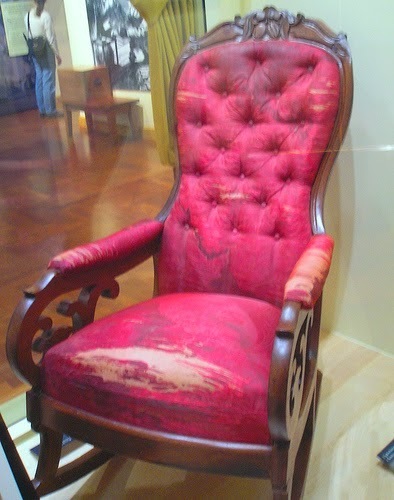 The first murder memorabilia I remember seeing was the chair President Abraham Lincoln was shot in by John Wilkes Booth in 1865. Henry Ford had the foresight to purchase the chair before it was lost to history.
The first murder memorabilia I remember seeing was the chair President Abraham Lincoln was shot in by John Wilkes Booth in 1865. Henry Ford had the foresight to purchase the chair before it was lost to history.Generations of Michigan youth have memories of trips to the Henry Ford Museum in Dearborn, Michigan and seeing this artifact of our shared national history, still stained with Lincoln's blood.
Some murderabilia has more historical significance than others to be sure. American collectors in post World War II bought up as much Nazi memorabilia as they could. These artifacts include weapons, uniforms, medals, helmets, flags, and Nazi government documents. It wasn't until the 1980s and the advent of the public internet that the fascination with serial killers began to dominate the murderabilia trade.
Countless magazine articles, books, movies, and cable television shows have made celebrity devils out of many of the most infamous killers in American history. Names like Richard Speck, Richard Ramirez, John Wayne Gacy, Jeffery Dahmer, and the poster boy for American serial killers Ted Bundy are widely known and have become part of the criminal folklore of America.
Some people think the marketing of murderabilia is grotesque and immoral, and it should be illegal. They argue that the promotion and marketing of these ruthless serial killers contributes to their celebrity folk status and larger than life portrayals. Much of the public is disgusted with the idea that convicted sex-slayers can parade around like celebrities nourishing their egos at the expense of their victims and their families.
 Son of Sam murders prompted new law.
Son of Sam murders prompted new law.Because of the feeding frenzy of New York publishers in 1977 to pay big money to David Berkowitz for the rights to tell his "Son of Sam" story, the New York State Assembly drafted and passed what is known as the "Son of Sam" law. The law's intent is to prevent convicted felons from profiting from their crimes through book publishers, film producers, or television networks. Convicts lose the ability to tell their own stories and profit from it.
Any money earned from "expressive or creative works" is deposited into an escrow account and then used to compensate crime victims and their families. Eight states currently have "notoriety-for-profit" laws that follow the money trial of murderabilia sales to insure that convicts don't make money indirectly through third-party involvement.
For my part, I have been purchasing the rights to every John Norman Collins related photograph available on the internet, not to buy and sell as murderabilia, but to use as research documentation in my true crime account of the Washtenaw County sex-slayings, The Rainy Day Murders. At some point, I will donate these photos and the government documents I have purchased to an archive in Ypsilanti, Michigan. For the record, I don't trade in murderabilia.
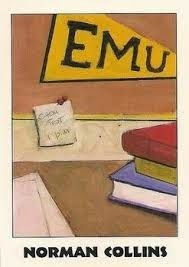 But recently I came across a site that sells Serial Killer Trading Cards, and I bought two of John Norman Collins' cards for under three dollars apiece. One for me and one for him. What prompted me to purchase them was that the card's writer got Collins' name wrong. It is listed as "Norman Collins." Norman Collins was a British author who is in no way related to John Norman Collins. Even in the subculture of murderabilia collectors, serial killer John Norman Collins cuts a sorry figure.
But recently I came across a site that sells Serial Killer Trading Cards, and I bought two of John Norman Collins' cards for under three dollars apiece. One for me and one for him. What prompted me to purchase them was that the card's writer got Collins' name wrong. It is listed as "Norman Collins." Norman Collins was a British author who is in no way related to John Norman Collins. Even in the subculture of murderabilia collectors, serial killer John Norman Collins cuts a sorry figure.
Published on November 19, 2014 07:47
November 12, 2014
Detroit's Greektown Stella - Iconic Homeless Woman Remembered
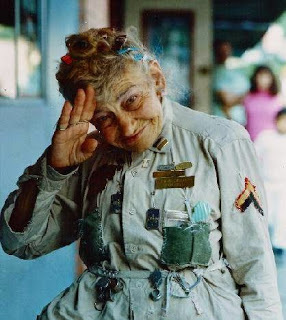 Photo taken of Stella Paris by a Detroit PolicemanI hadn't seen or heard of Greektown Stella for many decades, then several days ago, I found out that she had died almost four years earlier on January 16th, 2011. When I saw her photograph on a recent Facebook post on the Old Delray/Old Detroit site, I knew that face and suddenly felt very sad. Almost every time I have ever gone to a Greek restaurant or seen the film Zorba, the Greek, I privately think of the crazy old Greek woman who patrolled the dimly lit Greektown neighborhood in Detroit from the late1960's until the early 1990s.
Photo taken of Stella Paris by a Detroit PolicemanI hadn't seen or heard of Greektown Stella for many decades, then several days ago, I found out that she had died almost four years earlier on January 16th, 2011. When I saw her photograph on a recent Facebook post on the Old Delray/Old Detroit site, I knew that face and suddenly felt very sad. Almost every time I have ever gone to a Greek restaurant or seen the film Zorba, the Greek, I privately think of the crazy old Greek woman who patrolled the dimly lit Greektown neighborhood in Detroit from the late1960's until the early 1990s.She was like a modern day Cassandra that nobody wanted to listen to. Over forty years ago, whenever my friends and I would go to Greektown for dinner or shop at Trappers' Alley, Stella was often heard ranting something in Greek or broken English at the top of her lungs at all hours of the night. Stella's piercing voice would echo off the brick buildings. She was impossible to ignore. Because she was a permanent fixture on Monroe Street, we quipped that she was being paid by the restaurant owners to provide local color for the Greek neighborhood.
Several newspaper accounts at the time of her death list Stella Paris' age at ninety-five or older. No birth certificate, citizenship, or immigration documentation exists for her, so she was denied public assistance. She is believed to have been born on the Greek island of Samos.
Doug Guthrie, writing for The Detroit News on January 21, 2010, discovered that "(Stella) had come to this country in 1938 through an arranged marriage to restaurant owner John Perris. She raised three sons and never wanted to learn English (but she spoke broken English of necessity). Stella was four feet, ten inches tall and very trim. She passed away from a heart condition. Stella's body was laid out at Annunciation Greek Orthodox Cathedral on E. Lafayette Blvd.
In life, Stella suffered from mental illness and the scourge of schizophrenia. She had family who tried to take her in, but she wanted to be in Greektown where she felt comfortable, even when sleeping outside contending with the weather and other aggressive street people. She carried a nightstick for her protection, given to her by the police at the12th precinct downtown. "The Greek community took care of her by giving her food, shelter, and love," said Frank Becsi. "Stella is buried at Woodmere Cemetery."
"Stella was a blessing to me," says Shelley Rigney, someone who remembers her fondly. "I was young and she would always tell the 'Wolf' types not to bother me because my Mamma knew Jack Tocco (Detroit Mafia Don) & my Pappa was a big crazy Irishman & I was the only baby girl in a house full of Big Boys. She would laugh and tell me, 'Ya justa keep walkin'. Don't you let any of that Trash even stick to your shoe.' God bless her sweet soul & kind heart... I still have ribbons and all the things she gave me."
Stella led the hard life of a homeless street person. Even when she was in her fifties, she looked much older than she was. A retired Detroit policeman who wishes not to be identified walked the Greektown beat for years. He tells a more sobering, less romantic story of Stella's street life.
"(Stella) claimed to be some sort of Greek princess, or that her late husband was the king of Greece, or some similar story.... She would hear voices and stand on the street corner and yell at the voices... you could hear her half a mile away on a calm day.
"She was your basic homeless bag lady, and unfortunately, her mind was not all there.... Stella's favorite motel was police headquarters at 1300 Beaubien, just up the street from Greektown. Some (of the officers) took her in as a mascot, providing her with some old marksmanship badges, chevrons, and a nightstick (billy club) that she carried faithfully....
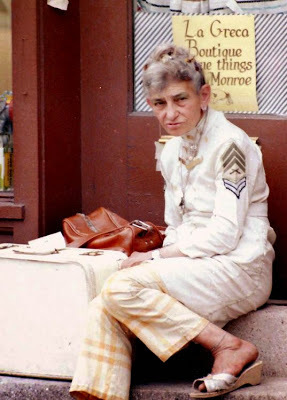 Stella on the street."I do know that many of the merchants in Greektown took pity on her regularly and provided her with food as needed. As I said, (Stella) was an icon. Actually, she was a perfect representative of so many mentally challenged people in the United States today."
Stella on the street."I do know that many of the merchants in Greektown took pity on her regularly and provided her with food as needed. As I said, (Stella) was an icon. Actually, she was a perfect representative of so many mentally challenged people in the United States today."Detroit policewoman Cynthia Hill said, "From our perspective, she never meant any harm. When I was working as a teenage police cadet, I noticed the officers let her sleep in the basement (of police headquarters) and bathe in our sinks in the women's restroom on the first floor. At first, she scared me. They told me, 'It's just Stella.' Later when I became an officer, I would see her on the street and feel the same way."
News of his mother's death came as a surprise to her seventy year old son, Anthony Perris of Livonia. He told The Detroit News reporter that her life began on the streets when she was in her fifties. "The family assumed she had died fifteen years ago when she disappeared from Greektown," Perris said. "We didn't know that she had been ordered by a judge into an assisted care facility because she was brandishing a knife."
Stella Paris spent the last years of her life peacefully at the East Grand Nursing Home on East Grand Blvd. At the time, the facility desperately searched for any relative who could shed light on her immigration status. Because of the common misspelling of her real last name, the Perris family was never notified. Stella was indigent, so the nursing home took her under its protective care. But when Stella needed heart surgery, they were simply not in any position to pay for her hospital bills.
We have all seen homeless people in our communities. Some do their best to be unobtrusive or obsequious, while others rant and rave, wrestling publicly with their personal demons. They are all desperate people living a tooth and nail existence. In our several encounters with Greektown Stella, my wife and I tried our best to avoid and not engage her in conversation because we didn't know what to expect from her. I regret that decision now.
Shelley Rigney laments, "Stella was a woman who was tossed aside by many, but she still managed to survive somehow. Now I wish I would have taken out real time for her. She had a lot to say and teach others."
My brother Rick suffered from schizophrenia and was never able to truly connect with other people or establish long term relationships. He eventually became homeless, drifted off for several years, and died a John Doe on a Denver street from a massive heart attack. With no identification on his person, it took two weeks to match his fingerprints to FBI records. His prints were in their files.
Finding out about Greektown Stella's death brought it all back to me. Rather than our scorn and apathy, these people need acts of kindness and generosity, not only during the holiday season but throughout the entire year.
More on Stella can be found in this link: http://www.mlive.com/news/detroit/index.ssf/2010/01/greektown_stella_shouts_no_mor.html
Published on November 12, 2014 05:30
November 5, 2014
The Ukrainian Holodomor (Hunger-Extermination) of 1932-1933
 Chicago American - Monday, February 25th, 1934Not widely known by many Americans, the
Holodomor
was the premeditated mass starvation of the Ukrainian peasantry in the name of Soviet collectivization of Ukraine's farmland in 1932-1933. Recent international human rights research estimates the number of dead at somewhere between 2.4 and 7.5 million victims. It is impossible to arrive at an accurate figure. But there is one thing that scholars agree upon, this was the worst peacetime catastrophe in Ukraine's long and fabled history. The loss of life rivals the Holocaust of European Jews by Adolph Hitler and the Nazis.
Chicago American - Monday, February 25th, 1934Not widely known by many Americans, the
Holodomor
was the premeditated mass starvation of the Ukrainian peasantry in the name of Soviet collectivization of Ukraine's farmland in 1932-1933. Recent international human rights research estimates the number of dead at somewhere between 2.4 and 7.5 million victims. It is impossible to arrive at an accurate figure. But there is one thing that scholars agree upon, this was the worst peacetime catastrophe in Ukraine's long and fabled history. The loss of life rivals the Holocaust of European Jews by Adolph Hitler and the Nazis.Since 2006, the Holodomor has been recognized by many countries as genocide of the Ukrainian people. History notes that the destruction of the Ukrainian peasantry was premeditated on the part of Joseph Stalin. The term Holomodor emphasizes the man-made causes of the famine, like the Soviet confiscation of private property, farmland, livestock, wheat crops, and all the implements of farm and industrial production.
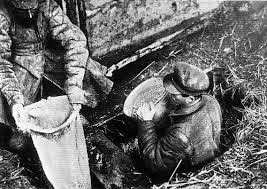 A campaign of terror was unleashed on ethnic Ukrainians, primarily in the southeastern "breadbasket" region of the country. Those who resisted Soviet authorities were shot or deported to Siberia. Families who attempted to hide their grain stocks were killed. Even so, some families chose to burn their homes to the ground and kill their livestock rather than hand them over to their Soviet overlords.
A campaign of terror was unleashed on ethnic Ukrainians, primarily in the southeastern "breadbasket" region of the country. Those who resisted Soviet authorities were shot or deported to Siberia. Families who attempted to hide their grain stocks were killed. Even so, some families chose to burn their homes to the ground and kill their livestock rather than hand them over to their Soviet overlords. A system of internal passports was instituted preventing the free movement of the Ukrainian populace from villages and towns to suppress widespread knowledge of what was occurring in Ukraine. When the news of the famine reached the West, the Ukrainian Diaspora in Western Europe and the United States quickly raised relief funds and sent food supplies to Ukraine which were rejected at the border by Soviet authorities. As a result of growing international notice, the Soviets responded by banning all journalists in Ukraine, and among the Ukraine populace, the banning of the words "famine" and "hunger." Using either word could result in a jail term.
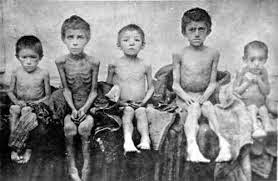
With the exception of grain reserves used to feed livestock and not people, the vast bulk of Ukrainian grain was exported to neighboring countries to generate revenue for fueling Stalin's Five Year Plan. The Soviet Union was able to purchase Western commodities, among them military weapons and hardware. In return, those countries turned a blind eye to the Soviet Union's internal problems.
In addition to Ukrainian farm peasants, more than 5,000 Ukrainian intellectuals were arrested and charged with plotting an armed rebellion. Those who were not summarily shot were deported to Siberian labor camps, never to be heard from again. It is believed that Stalin feared a general revolt in support of Ukrainian nationalism. The Soviet goal was to have Ukrainians abandon all nationalistic fervor. This preemptive move left the rest of the population without leadership or direction.
For more detailed information on Holodomor , visit the United Human Rights Council's site at:
http://www.unitedhumanrights.org/genocide/ukraine_famine.htm
To view the many monuments dedicated to the victims of Holodomor , tap on this link: http://en.wikipedia.org/wiki/Holodomor#mediaviewer/File:Holodomormemorialbloomingdale.jpg
Published on November 05, 2014 06:46
October 29, 2014
John Norman Collins and the Code of Silence

The most frustrating aspect of researching the Washtenaw County murders of 1967-1969 for The Rainy Day Murders is knowing that there are still people out there who are withholding information, from some sort of misguided loyalty or fear of self-incrimination.
I can understand that John Norman Collins' brother and sister want to distance themselves from the actions of their younger brother to protect their families. Of these murders, they knew nothing. But they could shed light on John's childhood and help us better understand why these terrible things happened.
Their mother Loretta Marjorie Collins was the unchallenged spokesperson for John during his arrest and trial for the murder of Karen Sue Beineman in 1970. Since her death in 1983, neither brother nor sister has commented publicly about their brother. So be it. They have lived with that decision for forty-seven years.
But then, there are others who have valuable knowledge about John Collins who are not as closely bound as family. A wall of silence still exists among many of Collins' Theta Chi fraternity brothers. I find it difficult to understand why, after he was kicked out of their frat house for the suspected theft of $40 from their social fund, that they still shield him. There also had been a rash of petty thefts in the W. Cross St frat house while Collins lived there.
 Eastern Michigan University Theta Chi fraternity members clean up the day after the annual welcome back party attended by more than 600 people.
Eastern Michigan University Theta Chi fraternity members clean up the day after the annual welcome back party attended by more than 600 people.And after John Collins moved out of the Theta Chi house, one of his former senior fraternity brothers got his 650cc Triumph motorcycle stolen. Collins kept it under wraps until the bike's owner had graduated and moved back to Benton Harbor on the west side of the state safely out of Ypsilanti. This was the same motorcycle that Karen Sue Beineman was last seen driving away on with Collins at the controls, before her body was discovered three days later at the bottom of a shallow gully.
My researcher Ryan M. Place and I were able to obtain the names and contact information for fifteen of Collins' former Theta Chi Brothers, requesting any information about Collins, either positive or negative, that we could get. We emailed everyone and in some cases made followup phone calls. Of the fifteen Theta Chi we contacted, only three responded. Two agreed to speak with us on the phone, while another met with us in person.
The first was extremely nervous over the phone for fear that his Brothers would discover that he had broken the fraternity Code of Silence. One valuable piece of information we learned from him was the name of the third man in the red and black car that picked up Joan Schell in 1968. Her nude body was found a week later in the outskirts of Ann Arbor shoved under some roadside shrubs.
The next Theta Chi to respond to our entreaties has been acting as John Norman Collins' legal adviser and spokesperson for many years. This meeting in his law office was one of those occasions. I told him what I was hoping to accomplish by writing this book and shared a few matters with him that he agreed to pass on to Collins in Marquette Prison.
Ryan and I were both struck with how uncomfortable he was, even in his own office at his own desk. Collins' mouthpiece put forth his belief that John was innocent and that another frat brother committed the crimes. If that was the case, why wait forty-five years to break the news and spring his client from false imprisonment? There is no evidence to even remotely suggest that anyone but Collins murdered Karen Sue Beineman. Why such loyalty after forty-seven years?
The last person to contact me was a former Theta Chi brother of John Collins, who also happened to be an Allen Park High School friend of mine. He gave me a full account of JNC's exile from Theta Chi but asked me not to reveal his name. Apparently, nobody wants to be marked lousy for ratting out a Brother.
From him, I learned about the theft of the motorcycle, an expensive bag of golf clubs, a stereo system, a color TV, and an expensive jeweled Theta Chi pin taken from another Theta Chi member. He said most of the Thetas were glad to see Collins leave their house, though a couple of their members left with Collins where they shared a boarding house at 619 Emmet St. around the corner and up the street, only one crooked block away from the Theta Chi house.
After pledges endure "secret" and usually humiliating hazing rituals, they take an oath of allegiance to one another which entitles them to all the rights, privileges, and protection of the Brotherhood. My question is this, when does that loyalty end? At what point does a person say, I draw the line at murder and mayhem? Theta Chi was conspicuous by its silence throughout the trial.
In a recent prison letter written to his Canadian cousin, Collins justifies the nobility of silence:
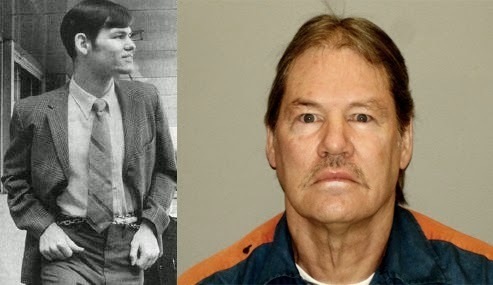 John Norman Collins in 1970 and in 2014."All my friends I grew up with had OLDER BROTHERS (me included) and you just didn't RAT anyone out. YOU JUST DIDN'T!!! If someone needed to be taken care of, we did it amongst ourselves. I still know "THINGS" that could get people arrested today. Most of them have turned out pretty good, e.g. cops, lawyers, and even a judge. Should I ruin their lives now? I don't think so. That's the "CODE" I grew up with, be it RIGHT OR WRONG? Let God judge that."
John Norman Collins in 1970 and in 2014."All my friends I grew up with had OLDER BROTHERS (me included) and you just didn't RAT anyone out. YOU JUST DIDN'T!!! If someone needed to be taken care of, we did it amongst ourselves. I still know "THINGS" that could get people arrested today. Most of them have turned out pretty good, e.g. cops, lawyers, and even a judge. Should I ruin their lives now? I don't think so. That's the "CODE" I grew up with, be it RIGHT OR WRONG? Let God judge that.""Then when I pledged Theta Chi with (name withheld), we took an OATH to always come to the aid of a Brother. I took that Oath seriously and to Rat Out (name withheld) wasn't "IN THE CARDS" for me at that time... I kind of believed in the SYSTEM in that they wouldn't convict an innocent man. While a few of us still believe in the Brotherhood, a few do not. You are only as good as your WORD." (sic)
There are three former Theta Chi members who are people of interest to us. One of them hasn't spoken for fear of self-incrimination. He was able to tell the prosecution just enough at the Collins' trial to be granted immunity and keep himself out of jail, before slithering away into relative obscurity.
We are certain that Collins' legal adviser knows key information also, but he is protected by lawyer/client confidentiality. Then there is the "third man" who has been pulling back his social media after we made our initial contact with him. His name has come up in connection with the first two coed murders but somehow he escaped notice and was never interviewed as a person of interest by local police. We are still trying to figure out why.
Published on October 29, 2014 14:34



